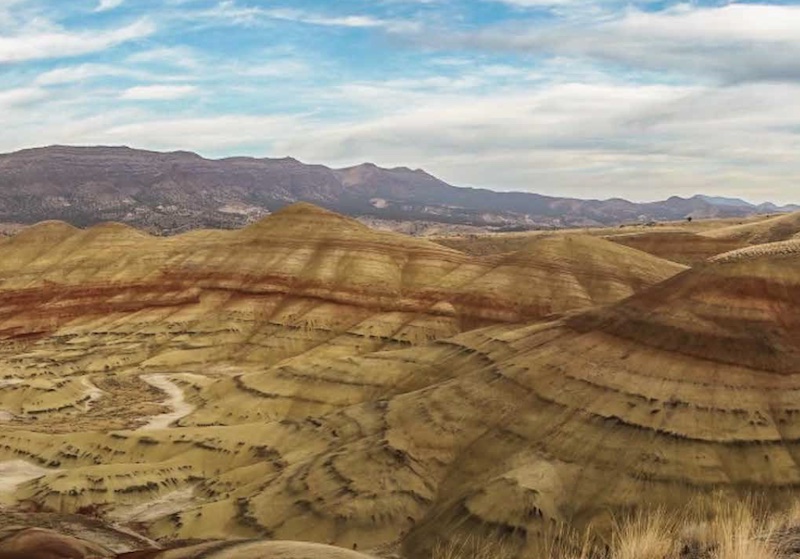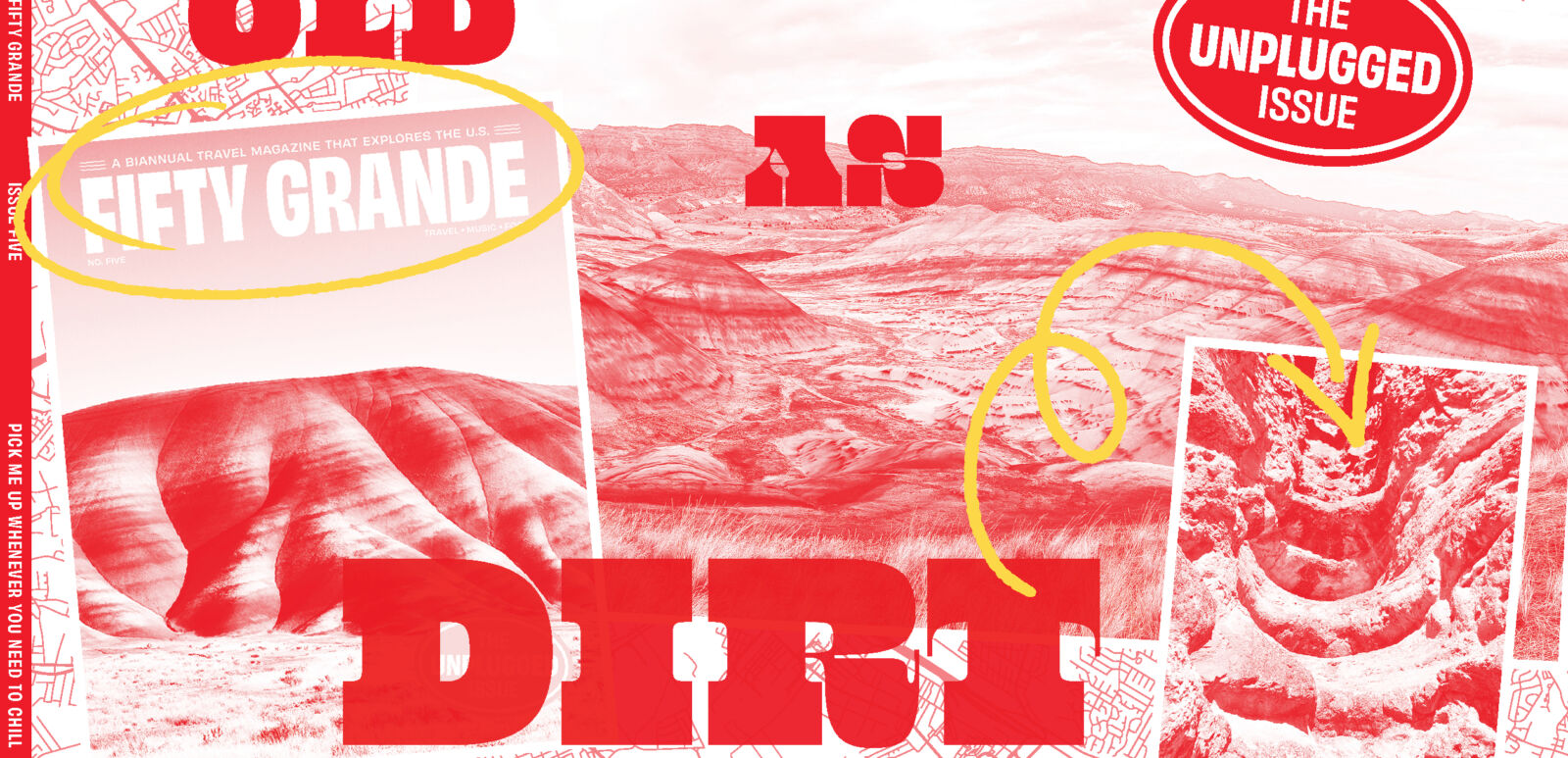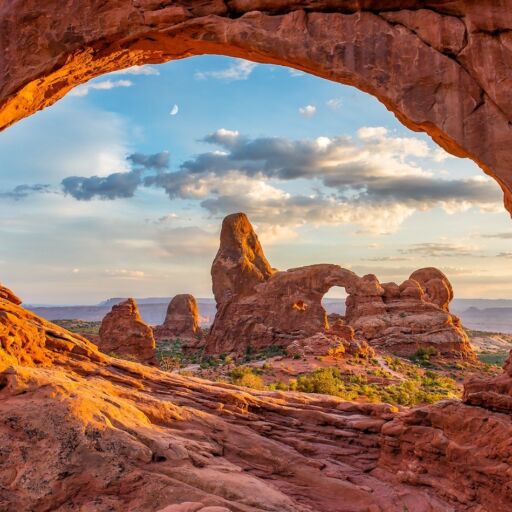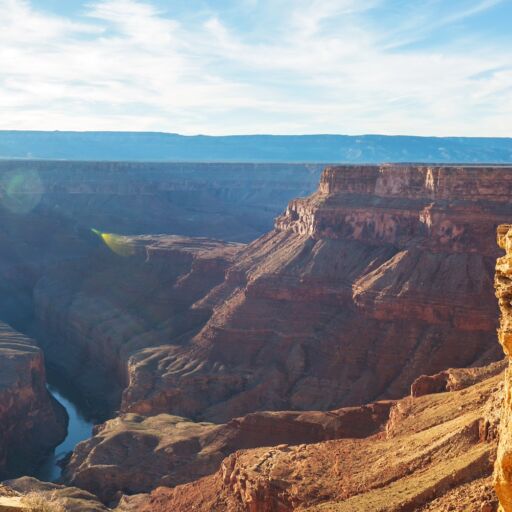This story appears in the Unplugged issue, in stores February 28 and available here.
Who knew dirt could be so beautiful? I kept repeating this as we rambled along an unpaved road in east-central Oregon, home of the John Day Fossil Beds National Monument. The park is arid landscape, more than 14,000 acres of it, dotted with scrub brush and not much else. But you visit John Day Fossil Beds because of the dirt — and it’s no ordinary dirt.
It’s one of 16 parks managed by the National Park Service, and the only park in Oregon, established solely because of its fossils. Like rings of a tree, the layered topography reveals to visitors like us petrified remains of life 7 to 44 million years ago.
The national monument is free to visit and it’s an accessible park with boardwalks, bridges and well-maintained trails and signage. It’s also dog friendly. This part of Oregon doesn’t offer much in the way of dining, shopping and accommodation options, making the fossil beds the true attraction (see where to stay and eat on page 95). Cell phone service is also spotty — embrace the disconnect — so when I visited, I mapped out the drive there, as well as the hikes and viewpoints we wanted to visit in advance. Since the three-section park — the distinct sections are the Painted Hills, the Sheep Rock and Clarno (named after an 1860s pioneer) — is so massive, here’s how you’ll want to spend two days at the fossil beds, whether you’re a hiker, rockhound, photographer or just want to see some really cool soil.
Day 1: The Painted Hills

The most iconic of the three John Day Fossil Bed units, the Painted Hills has been dubbed one of Oregon’s Seven Natural Wonders. Here, the earth has assembled itself into stretches of rolling hills. It’s not the shape of the neck-craning mountains that wow you, but the autumn-like hues of reds, oranges and golds.
We arrived at the park just as magic hour (a.k.a. that time of day before the sun rises or sets when the softer light makes everything radiant) was settling in. And after a 3.5- hour drive from Portland, it provided a brilliant break from being jammed in a car. To our surprise, except for an older pair traveling in their RV, we had the park to ourselves. In fact, in October, each day at the park was virtually empty, making it all the more peaceful.
The area has evolved from several different landscapes. Thirty-three to 29 million years ago, the area was once a verdant floodplain, then a lush tropical forest, home to prehistoric animals and plants. Today, thanks to layers of volcanic ash mixed with fossilized plant and animal life, the hills are multi-colored striations of red, orange, tan and yellow to black, green and even lavender.
My husband and I, with our small dog in tow, began exploring at the Painted Cove Trail. This short trail, just .25 miles round-trip, brushes up against hills the color of clay. Upon closer inspection, the red dirt looked rippled and cracked, like it was severely dehydrated. We learned from signs along the trail that the soil contains leaf fossils that are 30 to 39 million years old. The dirt is delicate, so there’s a wood boardwalk perched above to help preserve it, that also makes it approachable for hikers of all types. Watch where you step, and heed the park’s signs saying, “Don’t hurt the dirt.” (We noticed several sets of footprints from disrespectful visitors, which will remain until the next heavy rain.)
Next, we hopped back into the car and drove about five minutes to the Carroll Rim Trail, a 1.6-mile path that gave us a bird’s-eye view of the area. At the top, you can see all the knolls comprising the Painted Hills, and how time had folded and layered a muted rainbow of colors. It’s the perfect spot to watch the sun set. The sunset that night lit the hills on fire and bathed the hills in vibrant shades of red, orange, pink and blue. I quickly understood how this area was given its moniker. Impressive any time of day, the hills are truly stunning at sunset. It’s the best sunset I’ve seen in Oregon.
Day 2: Sheep Rock Unit
The next day, we visited Sheep Rock, the second unit of our John Day Fossil Beds tour. The area is named for the bighorn sheep that once roamed the slopes. It’s also home to the Thomas Condon Visitor Center. The center’s namesake, a paleontologist from Ireland, helped elevate the geographical and ecological significance of this part of Oregon. The visitor center isn’t very big, or particularly elaborate, but my husband and I still enjoyed meandering through the exhibits. We also had it mostly to ourselves.
The center houses a collection room with more than 60,000 fossils and specimens. It made for an educational start to our day as we walked through the Age of Mammals exhibition, detailing life in the area from around 50 million years ago. My favorite part, though, was watching a paleontologist clean a softball-size fossilized stone. Visitors can look into the center’s large windows and watch researchers at work. In fact, according to the NPS, there are more than 750 active fossil sites within the John Day Basin, many of which are inside the monument. Entrance to the center is free. It also has a balcony with picnic tables.
At 3.25 miles round-trip, Blue Basin Overlook is the longest hike in the national monument, and that’s where we headed next after filling up our water bottles at the center. At this point in the afternoon, the sun baked the air, reminding me I was in a desert — in Oregon! We huddled under little shade spots we found along the trail to hydrate, while taking in all the different angles of the hills. And since we only saw three other people on the trail, the seclusion of the area only intensified.
The dirt trail snakes in and out of the area’s hillsides, alternating between close-ups and panoramic views of the blue-green hillsides. Millions of years ago, the light green mineral celadonite morphed the claystone into its now peculiar shade of pistachio green. And unlike the smooth pleats of the Painted Hills, the formations in the Sheep Rock unit are craggy and jagged.
The area contains mammal fossils from 29 million years ago, part of what’s known as the Turtle Cove Assemblage. But the animals that roamed here weren’t turtles, but rather mouse deer, nimravids, ferocious cat-like animals and the brutish entelodonts (giant pig-like ungulates that would grow to be the size of a horse). Placards along the trail detail a much wilder and more inhabited ecosystem. The only wildlife we spotted were birds.
Bonus Day: Clarno Unit
If you have time, or are a rockhound looking for higher concentrations of fossils, visit the Clarno unit. Located outside the small, aptly named town of Fossil, this section of the park has hikes and viewpoints that showcase the area’s diverse ecological history. More than 173 species of trees and plants have been found here, as well as fossils of mammals including tiny four-toed horses and the predecessor of modern-day carnivores. The short Trail of Fossils spotlights just that: leaf fossils, petrified wood and more.
As we drove home from east-central Oregon, soon enveloped by sprawling conifer and pine forests, then urban development, I was struck again by the sharp contrast of the fossil beds, and evidence of all the life it supported tens of millions of years ago. There’s nothing like the remaining bits of prehistoric fossils to help put the everyday hustle of life into context.
Beautiful dirt will do that.




